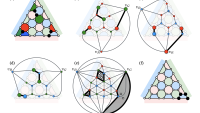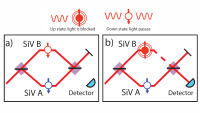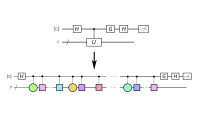In January 2021, Antia Lamas-Linares joined Amazon Web Services (AWS) to work on quantum technologies.
A quantum information scientist, Lamas-Linares is an expert in quantum optics. More precisely, in photonic (optical) implementations of quantum-information protocols. Her career to date includes pioneering research on quantum key distribution — formerly known as quantum cryptography — superconducting single-photon detectors and space-based quantum technology (including several patents), in addition to high-performance computing.
Quantum science and technologies are evolving fast, and for the first time, small prototype quantum computers are appearing around the world. Indeed, the Amazon Braket service provides access to these computers for researchers and institutions. AWS itself announced the opening of its Center for Quantum Computing in October 2021. While quantum processors already exhibit some interesting quantum mechanical behaviors, they have some way to go before they outperform “classical” computers in truly disruptive ways.
Quantum computers work through the manipulation of quantum bits, known as qubits, instead of conventional digital bits. Lamas-Linares joined AWS to focus on research related to connecting quantum devices with each other.
“You can think of quantum computing as dealing with stationary qubits and quantum networking as dealing with ‘flying qubits’ – qubits going from A to B,” says Lamas-Linares.
Quantum networking
To understand the coming importance of quantum networking, first consider a central disruption that quantum computers are ultimately expected to deliver: a potential, future threat to modern digital security. That is because quantum computers have the potential to outperform classical computers, including the ability to break encryption methods currently relied on for modern communications and data security.
“This once-remote threat of a hypothetical quantum computer breaking modern encryption is becoming less of a hypothetical and more of a ‘not if but when’,” says Lamas-Linares.
One potential solution to this challenge would be go “full quantum” in how information is protected in the first place, says Lamas-Linares, using quantum encryption keys.
“One of the main applications — and low-hanging fruit — of quantum networking is the ability to distribute those keys securely. This involves exploiting the inherent randomness and correlations that exist in quantum systems to create perfectly secure correlated numbers that can then be used for cryptography.”
In short, quantum networking has the potential to also deliver perfect privacy. It would be easy to fall down a quantum rabbit hole here. Suffice it to say, quantum entanglement — a fundamental quantum phenomenon — can be exploited to distribute these keys in such a way that no intermediary company involved in the warehousing or transmitting of data would be able to access that data.
Only the possessor of the quantum keys — the data owners — can decrypt and access that data. In the future, such perfect protection of customer data will be crucial to every organization, from financial institutions and governments to hospitals and industry. The goal of quantum key distribution is to securely transmit those keys to where they need to be.
“At AWS we often say that security is job zero — more important than any other priority. That’s because if customers don't trust the cloud, then most business models just won’t work in the cloud. Customers need confidence that their data and transactions are secure,” says Lamas-Linares.
Mathematical games
The first quantum cryptography protocol, theoretical but provably secure, was called BB84 and published in 1984. At the time, a young Lamas-Linares was growing up in Santiago, Spain, busily getting hooked on mathematics and physics: she did not yet speak English, but recalls her parents owned the Spanish translation of a collection of classic “Mathematical Games” columns from Scientific American, written by Martin Gardner.
“That really caught my attention — I was fascinated,” says Lamas-Linares. Later, in 1988, Stephen Hawking’s “The Brief History of Time” further captivated her. “It’s kind of a cliché, but that book set me on my path.”
It was a path that took Lamas-Linares to study physics at the University of Santiago de Compostela. After graduating, Lamas-Linares moved for a year to the University of Sheffield, UK, via the European Union’s Erasmus student exchange program, before spending a year completing a master’s in applied optics at Imperial College London.
Why the focus on optics?
[Optics] is one of these fields in physics where you can literally see the things that are happening. If you study optics from a mathematical point of view, it’ll tell you something that you can recreate perfectly with light and lenses.
“It’s one of these fields in physics where you can literally see the things that are happening. If you study optics from a mathematical point of view, it’ll tell you something that you can recreate perfectly with light and lenses. I thought that was really cool,” she said.
Then Lamas-Linares started learning about quantum optics, and so-called “squeezed states” of light. Being quantum, and therefore tiny, this is physics you cannot see with your eyes, but she thought it was cooler still. In 2003, Lamas-Linares completed her doctorate in physics at the University of Oxford.
Lamas-Linares’s subsequent career has continued an international trend. Highlights include becoming an assistant professor at the National University of Singapore (NUS), where she soon set up a new quantum optics lab and became principal investigator at the university’s Centre for Quantum Technologies. She later became a senior research fellow at the US National Institute of Standards and Technology in Boulder, Colorado, and a research associate doing high performance computing at the Texas Advanced Computing Center in Austin.
Moving into industry
When Lamas-Linares made the move from academia to industry, it was to join an NUS spinout company, SpeQtral, as chief quantum scientist in 2019. The switch resulted from an itch for her work to have more direct real-world impact.
“Academia is full of what we call hero experiments, where you make something work once, but maybe afterward it self-destructs or melts or something; the important thing is you showed something was possible; a viable effect. That’s great, but it’s nowhere near what you need to create a useful technology,” says Lamas-Linares. “First and foremost, I'm an experimentalist — I build devices. And I wanted to build robust versions of useful technology. That sort of engineering challenge doesn’t make sense for academia — you have to go to industry. I want to bring quantum technologies to the point where it is the ‘best’ solution to a technical problem and so it becomes part of the standard toolbox.”
SpeQtral pioneers the development of miniaturized sources of quantum-entangled photons, designed to be deployed on satellites as a means to distribute quantum keys around the Earth. The company has successfully demonstrated such miniaturized technology in space, using its shoebox sized “cubesat”, SpooQy-1.
“SpeQtral had already put an entanglement source in space when I joined as chief quantum scientist,” Lamas-Linares recalls. “By this time I’d been working in the field for two decades, having done a lot of work on entanglement sources, but also on whole systems designed to implement quantum key distribution systems over free space, and in hacking those same systems to show which parts needed further thought.”
While at SpeQtral, industry networking meant Lamas-Linares talked with Amazon about this technology. “That’s how I became more aware of what that Amazon was doing things in quantum technologies,” says Lamas-Linares. “It turned out that one of my former colleagues, Simone Severini, was working at AWS in quantum computing. One day he said to me: ‘Hey, we're doing really interesting stuff. Would you be interested in joining us?’.”
What was it that Severini saw in Lamas-Linares?
“I’ve known Antia professionally for about 20 years, and have always been struck by her adaptability and the fact that she is a real ‘owner’,” he says. “Ownership is fundamental in a complex, pioneering environment like this. Nobody is telling you exactly what to do — you have to find your own way, and push when you find friction. “Antia fits Amazon very well — she has a strong bias for action.”
Amazon’s appeal
For Lamas-Linares’s part, she was attracted to Amazon’s resources, capability, and very long-term vision.
“Amazon is only interested in building things that have a clear application and benefit for their customers, but if they are convinced of that customer value, they will invest for as many years as necessary to reach the required level of technological readiness,” she explained. “That’s exciting, and it’s much harder to do in the start-up/venture capitalist environment, particularly with complicated hardware products.”
One of the main challenges in making strides in quantum networking, says Lamas-Linares, is technological integration.
“Whatever quantum technology you develop, before it can be of any use to your customers, an entire ecosystem of additional technology needs to be built up around it, and the people needed to do that barely exist for quantum technologies. Finding that combination of expertise and building the required tools is a non-trivial challenge.”
As quantum technologies are taken up by industry, we’re starting to make the molds for what quantum engineers will be. That, to me, is really exciting.
The sheer newness of many quantum technologies makes it tricky to orchestrate a successful career in the field. Does Lamas-Linares, herself in the first wave of scientists to gain a PhD in quantum technology, have any advice to offer?
“I am definitively not qualified to give anyone advice, but I would say this: Don’t be afraid to take an unconventional path. Especially in emerging fields like this, you just don’t know what the right combination of skills and experience will turn out to be.”
Lamas-Linares points out that “quantum engineers” don’t really exist as yet.
“Engineers take established knowledge and they perfect it. As quantum technologies are taken up by industry, we’re starting to make the molds for what quantum engineers will be. That, to me, is really exciting.”





















